Chapter 12 - International Trade
0.0(0)
Card Sorting
1/35
Study Analytics
Name | Mastery | Learn | Test | Matching | Spaced |
|---|
No study sessions yet.
36 Terms
1
New cards
Law of comparative advantage
It says that nations can mutually benefit from trade so long as the relative production costs differ at the macroeconomic level
2
New cards
Comparative advantage
When a company can produce a good at a lower opportunity cost than another.
3
New cards
Absolute advantage
When a company has the capability to produce more of the same good than another
4
New cards
what does trade rely on
comparative advantages
5
New cards
Consumption possibility frontier
The line that connects Indiana’s specialization of soybeans to Oregon’s specialization of timber
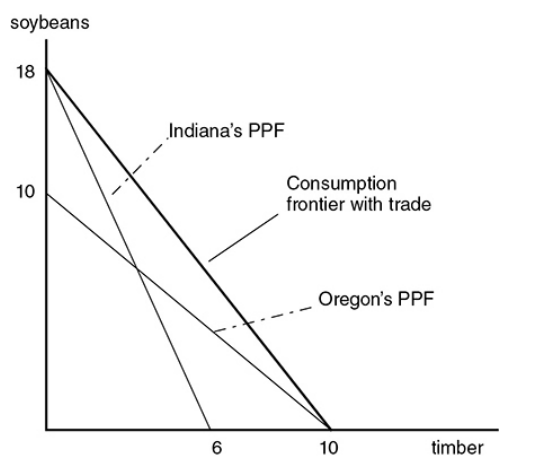
6
New cards
what does specialization and trade allows
they allow nations to consume beyond the PPC
7
New cards
what does free trade allows based on comparative advantages
it allows for a more efficient allocation of resources and greater prosperity for the trading partners than can be achieved without free trade.
8
New cards
World price
The global equilibrium price of a good when nations engage in trade
9
New cards
Domestic price
The equilibrium price of a good in a nation without trade
10
New cards
world price is above domestic price
the nation becomes an exporter
11
New cards
world price below domestic price
the nation becomes an importer
12
New cards
Balance of payments statement
A summary of the payments received by the United States from foreign countries and the payments sent by the United States to foreign countries
13
New cards
Current account
This account shows current import and export payments of both goods and services and investment income sent to foreign investors of the United States and investment income received by U.S. citizens who invest abroad
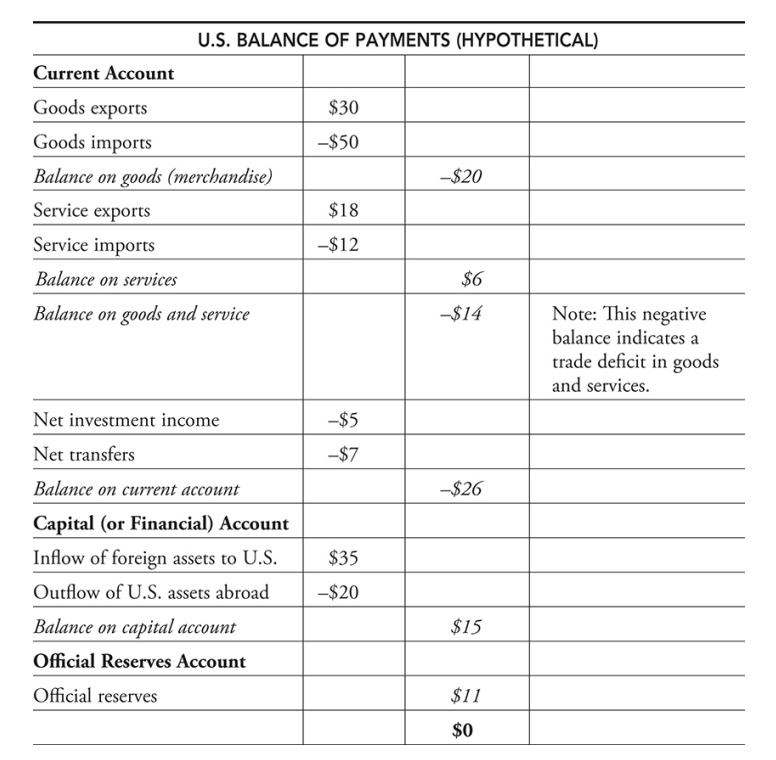
14
New cards
what does a deficit balance tells us
that the United States sent more American dollars abroad than foreign currency received in current transactions
15
New cards
Capital (or financial) account
This account shows the flow of investment on real or financial assets between a nation and foreigners
16
New cards
what does a surplus balance tells us
that there was more foreign capital investment in the United States than there was U.S. investment abroad
17
New cards
Official reserves account
The Feds adjustment of a deficit or surplus in the current and capital account by the addition or subtraction of foreign currencies so that the balance of payments is zero
18
New cards
Balance of payments deficit
When the US has sent more dollars out than foreign currency has come in while adding the current and capital account. When this happens, the Fed credits the account to balance it.
19
New cards
Balance of payment surplus
When more foreign currency was coming into the US than American dollars sent abroad. Here, the Fed transfers the surplus currency bank into official reserves.
20
New cards
Exchange rate
The price of one currency in terms of a second currency
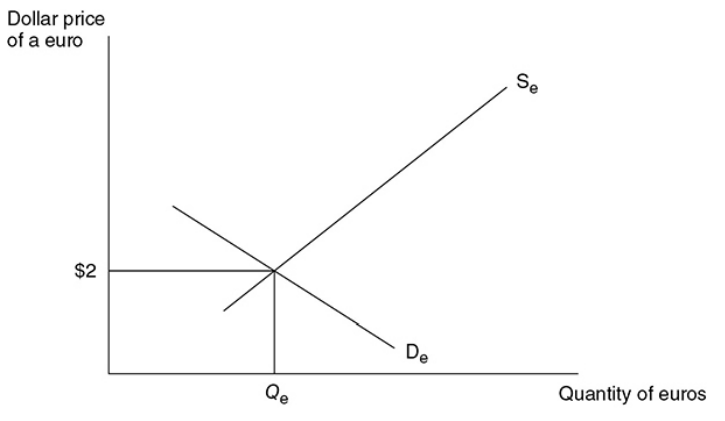
21
New cards
Appreciating or stronger currency
When the value of a currency is rising relative to another currency

22
New cards
Depreciating or weaker currency
When the value of a currency is falling relative to another currency
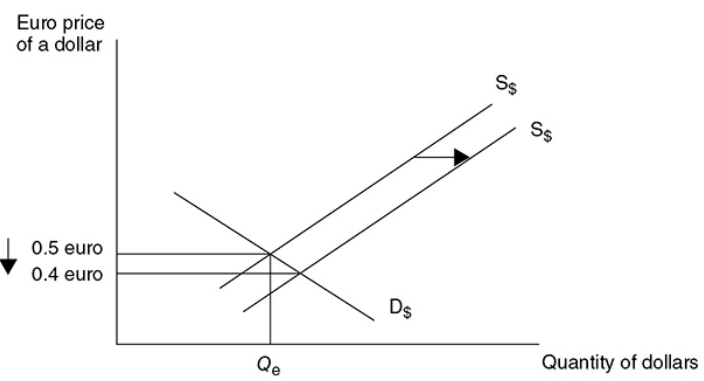
23
New cards
Determinants of exchange rates
External factors that increase the price of one currency relative to another
24
New cards
Consumer tastes
When domestic consumers build a stronger preference for foreign-produced goods and services, the demand for those currencies increases and the dollar depreciates.
\
If foreign consumers increase their demand for U.S.-made goods, the dollar appreciates.
\
If foreign consumers increase their demand for U.S.-made goods, the dollar appreciates.
25
New cards
Relative incomes
When a nation’s macroeconomy is strong and incomes are rising, they increase their demand for all goods, including those produced abroad
26
New cards
Speculation
Foreign currencies can be traded as assets causing investors to seek to profit from buying currency at a low rate and selling it at a higher rate
27
New cards
what happens when the fed increases the money supply
The interest rates on American financial assets begin to fall, so the demand for the dollar falls and it depreciates relative to other foreign currencies. This increases American net exports shifting AD to the right
28
New cards
what happens when the fed decreases the money supply
American interest rates begin to rise and the dollar appreciates relative to foreign currencies.
This decreases American net exports which shifts AD to the left.
This decreases American net exports which shifts AD to the left.
29
New cards
what happens when interest rates rise
capital investments decrease and financial investments increase.
30
New cards
when does the demand for the US dollar increases and the dollar appreciates relative to the euro
When:
* European taste for American-made goods is stronger.
* European relative incomes are rising, increasing demand for U.S. goods.
* The U.S. relative price level is falling, making U.S. goods relatively less expensive.
* Speculators are betting on the dollar to rise in value.
* The U.S. relative interest rate is higher, making the United States a relatively more attractive place for financial investments
* European taste for American-made goods is stronger.
* European relative incomes are rising, increasing demand for U.S. goods.
* The U.S. relative price level is falling, making U.S. goods relatively less expensive.
* Speculators are betting on the dollar to rise in value.
* The U.S. relative interest rate is higher, making the United States a relatively more attractive place for financial investments
31
New cards
Revenue tariff
An excise tax levied on goods not produced in the domestic market
32
New cards
Protective tariff
An excise tax levied on a good that is produced in the domestic market so that it may be protected from foreign competition
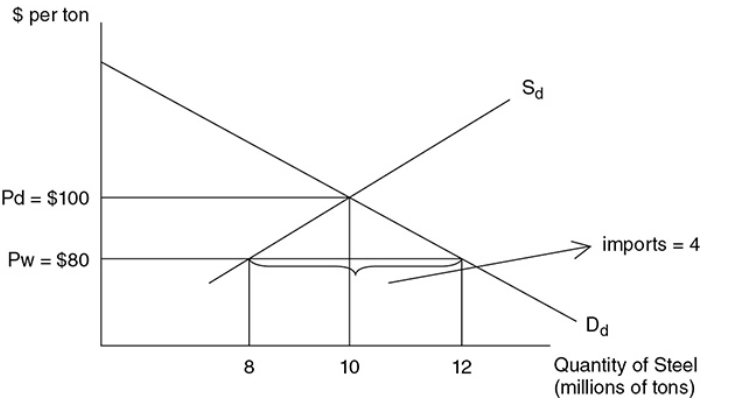
33
New cards
economic effects on the tariff
* **Consumers pay higher prices and consume less steel**
* **Consumer surplus has been lost**
* **Domestic producers increase output**
* **Declining imports**
* **Tariff revenue**
* **Inefficiency**
* **Deadweight loss now exists**
* **Consumer surplus has been lost**
* **Domestic producers increase output**
* **Declining imports**
* **Tariff revenue**
* **Inefficiency**
* **Deadweight loss now exists**
34
New cards
Import quota
A limitation on the amount of a good that can be imported into the domestic market
\
* With a quota, the government only allows two million tons to be imported. So the impact of the quota, with the exception of the revenue, is the same: higher consumer price and inefficient resource allocation.
\
* With a quota, the government only allows two million tons to be imported. So the impact of the quota, with the exception of the revenue, is the same: higher consumer price and inefficient resource allocation.
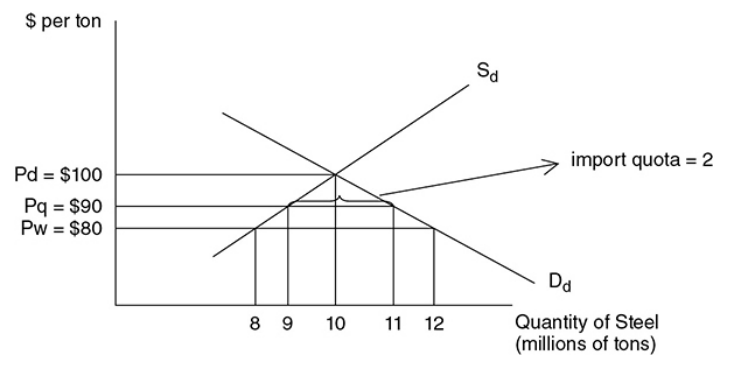
35
New cards
Tariffs and quotas economic effects
* Both hurt consumers with artificially high prices and lower consumer surplus.
* Both protect inefficient domestic producers at the expense of efficient foreign firms, creating deadweight loss.
* Both reallocate economic resources toward inefficient producers.
* Both protect inefficient domestic producers at the expense of efficient foreign firms, creating deadweight loss.
* Both reallocate economic resources toward inefficient producers.
36
New cards
difference between tariffs and quotas
Tariffs collect revenue for the government, while quotas do not.